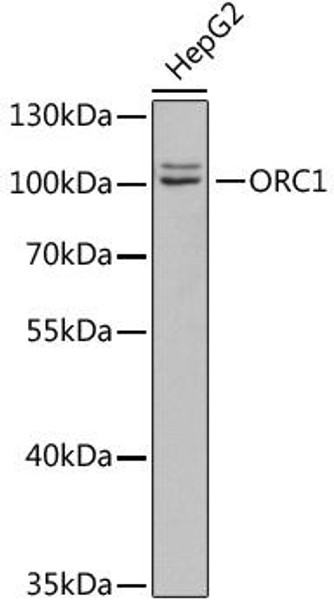Epigenetics & Nuclear Signaling Antibodies 5
Anti-ORC1 Antibody (CAB5285)
- SKU:
- CAB5285
- Product Type:
- Antibody
- Reactivity:
- Human
- Host Species:
- Rabbit
- Isotype:
- IgG
- Research Area:
- Epigenetics and Nuclear Signaling
Description
| Antibody Name: | Anti-ORC1 Antibody |
| Antibody SKU: | CAB5285 |
| Antibody Size: | 20uL, 50uL, 100uL |
| Application: | WB |
| Reactivity: | Human |
| Host Species: | Rabbit |
| Immunogen: | A synthetic peptide of human ORC1. |
| Application: | WB |
| Recommended Dilution: | WB 1:500 - 1:2000 |
| Reactivity: | Human |
| Positive Samples: | HepG2 |
| Immunogen: | A synthetic peptide of human ORC1. |
| Purification Method: | Affinity purification |
| Storage Buffer: | Store at -20'C. Avoid freeze / thaw cycles. Buffer: PBS with 0.02% sodium azide, 50% glycerol, pH7.3. |
| Isotype: | IgG |
| Sequence: | Email for sequence |
| Gene ID: | 4998 |
| Uniprot: | Q13415 |
| Cellular Location: | Nucleus |
| Calculated MW: | 97kDa |
| Observed MW: | 100kDa |
| Synonyms: | ORC1, HSORC1, ORC1L, PARC1 |
| Background: | The origin recognition complex (ORC) is a highly conserved six subunits protein complex essential for the initiation of the DNA replication in eukaryotic cells. Studies in yeast demonstrated that ORC binds specifically to origins of replication and serves as a platform for the assembly of additional initiation factors such as Cdc6 and Mcm proteins. The protein encoded by this gene is the largest subunit of the ORC complex. While other ORC subunits are stable throughout the cell cycle, the levels of this protein vary during the cell cycle, which has been shown to be controlled by ubiquitin-mediated proteolysis after initiation of DNA replication. This protein is found to be selectively phosphorylated during mitosis. It is also reported to interact with MYST histone acetyltransferase 2 (MyST2/HBO1), a protein involved in control of transcription silencing. Alternatively spliced transcript variants encoding different isoforms have been found for this gene. |
| UniProt Protein Function: | ORC1L: Component of the origin recognition complex (ORC) that binds origins of replication. DNA-binding is ATP-dependent, however specific DNA sequences that define origins of replication have not been identified so far. ORC is required to assemble the pre-replication complex necessary to initiate DNA replication. ORC is composed of six subunits. In human, ORC is cell cycle-dependent regulated: it is sequentially assembled at the exit from anaphase of mitosis and disassembled as cells enter S phase. Interacts with CDC6 and KAT7/HBO1. Belongs to the ORC1 family. |
| UniProt Protein Details: | Protein type:DNA-binding; Motility/polarity/chemotaxis Chromosomal Location of Human Ortholog: 1p32 Cellular Component: nucleoplasm; cytoplasm; plasma membrane; nucleolus; nuclear origin of replication recognition complex; cytosol; nucleus; origin recognition complex Molecular Function:protein binding; DNA binding; chromatin binding; ATP binding Biological Process: G1/S-specific transcription in mitotic cell cycle; DNA replication initiation; mitotic cell cycle; DNA replication; G1/S transition of mitotic cell cycle Disease: Meier-gorlin Syndrome 1 |
| NCBI Summary: | The origin recognition complex (ORC) is a highly conserved six subunits protein complex essential for the initiation of the DNA replication in eukaryotic cells. Studies in yeast demonstrated that ORC binds specifically to origins of replication and serves as a platform for the assembly of additional initiation factors such as Cdc6 and Mcm proteins. The protein encoded by this gene is the largest subunit of the ORC complex. While other ORC subunits are stable throughout the cell cycle, the levels of this protein vary during the cell cycle, which has been shown to be controlled by ubiquitin-mediated proteolysis after initiation of DNA replication. This protein is found to be selectively phosphorylated during mitosis. It is also reported to interact with MYST histone acetyltransferase 2 (MyST2/HBO1), a protein involved in control of transcription silencing. Alternatively spliced transcript variants encoding different isoforms have been found for this gene. [provided by RefSeq, Jun 2010] |
| UniProt Code: | Q13415 |
| NCBI GenInfo Identifier: | 299890793 |
| NCBI Gene ID: | 4998 |
| NCBI Accession: | NP_001177747.1 |
| UniProt Related Accession: | Q13415 |
| Molecular Weight: | |
| NCBI Full Name: | origin recognition complex subunit 1 isoform 1 |
| NCBI Synonym Full Names: | origin recognition complex subunit 1 |
| NCBI Official Symbol: | ORC1 |
| NCBI Official Synonym Symbols: | ORC1L; PARC1; HSORC1 |
| NCBI Protein Information: | origin recognition complex subunit 1 |
| UniProt Protein Name: | Origin recognition complex subunit 1 |
| UniProt Synonym Protein Names: | Replication control protein 1 |
| Protein Family: | Origin recognition complex |
| UniProt Gene Name: | ORC1 |
| UniProt Entry Name: | ORC1_HUMAN |
View AllClose







